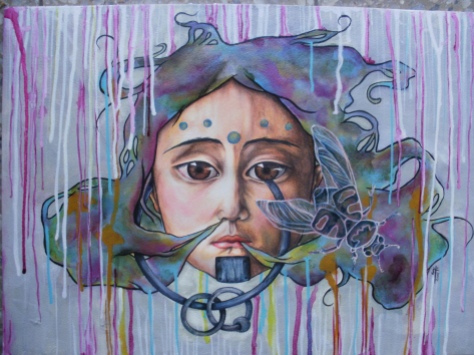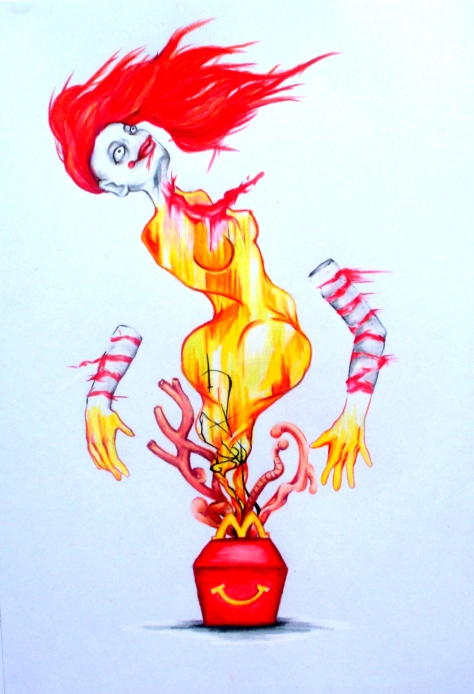Cada viernes, estaremos posteando algo que sobresale de la sociedad y la cultura hondureña. Este viernes, queremos celebrar el arte hondureño.
Every Friday, we will be posting about something that stands out in Honduran culture and society. This Friday, we want to celebrate Honduran art. See version in English below.
Escrito por: Megan Turley
En mis tres años de estar en Honduras, he tenido la oportunidad de aprender un poco más sobre el arte. Tengo el privilegio de conocer a varixs artistas por medio de mis conexiones y he visto también una creciente cultura de arte callejero en los últimos años. Para mí el arte es una manera de expresarse tanto como individuos como sociedad; y valorar el arte hondureño es valorar una voz profética y a la vez íntima de la sociedad.
Me he topado con algunxs artistas por medio de amistades; por ejemplo, Rei Blinky que es un artista que también hace muchas obras en la calle estilo graffiti. También, he compartido en casa de Dennis Cerrato porque su familia ha sido familia anfitriona para algunxs compañerxs. También, con Miriam Sabas que es una amiga que conocí por medio de la Iglesia Menonita en Tegucigalpa. A ella le conocí en el primer retiro nacional de jóvenes menonitas en Tegucigalpa al que asistí cuando recién llegué a Honduras. Recuerdo que platicaba con ella y sus hermanxs mientras buscamos un poco de sol donde podríamos calentarnos porque estaba haciendo mucho frío en El Hatillo.
Después me di cuenta que era una artista. Vi unas fotos de su arte en la internet y me fascinaron sus figuras llamativas. Me llama mucha la atención su trabajo y su manera de pensar sobre su arte y quise entender un poco más del arte en Honduras y de su arte en particular. Por eso, le pedí que me compartiera un poco y también le pedí que compartiera algunas obras suyas.
Megan: ¿Cómo describirías tu arte?
Miriam: Bien para describir mi arte, creo que podría usar la palabra versatilidad, ya que amo las variadas formas de arte visual. Utilizo acuarela, acrílicos y lápices de color para convertir en realidad mi imaginación, siendo estos últimos lo que puedo utilizar como de si de otra de mis extremidades se tratara. Como gran admiradora de la figura y sensibilidad humana, busco imbuir mis obras de un estilo y significado que sea propio, me plazco mucho en dejar en enigma la comprensión de mis obras, prefiero que el impacto de la ilustración que de a la determinación del espectador.
Megan: ¿Cómo describirías la escena de arte en Honduras?
Miriam: Acerca de esto solía pensar lo que la mayoría en el país piensa “no hay apoyo al arte”, resulta que sigo pensando lo mismo, pero desde otro enfoque; me he dado cuenta que no necesitas apoyo para sentarte frente a un muro sucio y maltrato o las paredes viejas de un edificio y convertirlo en algo pintoresco, solo necesitas querer.
El arte: “Solo necesitas querer.”
Lastimosamente no he sido parte de este movimiento de arte en las calles, pero creo que ha sido de mucho impacto, y no solo esto, tenemos también el acceso a internet y es mucho mas fácil darte a conocer a través de él; me hace pensar que querer es poder, aunque otros en tu país no te quieran ayudar.
Written by: Megan Turley
In my three years of being in Honduras, I have had the opportunity to learn a little about art. I have the privilege of getting to know several artists through my connections and I have also seen a street art culture that has grown in the last few years. For me, art is a way of expression of both individuals and society; and valuing Honduran art is valuing a voice that is at the same time a prophetic voice and an intimate voice of society.
I have bumped into some artists through friends: for example, Rei Blinky who is an artist who also does a lot of works on the streets, graffitti style. Also, I’ve visited the home of Dennis Cerrato because his family has been a host family to some coworkers. Also, Miriam Sabas, who is a friend that I met through the Mennonite Church of Tegucigalpa. I met her in the first national Mennonite youth/young adult retreat that I went to when I had recently arrived to Honduras. I remember chatting with her and her siblings while we sought out a patch of sun to sit in where we could warm up because it was very cold in El Hatillo.
Afterwards I learned that she was an artist. I saw her work on the internet and her striking figures fascinated me. Her work and her way of thinking about her art caught my attention, and I wanted to learn a little more about the art scene in Honduras and her art in particular. So I asked her to share a little bit and also share some of her works. (see works above)
Megan: How would you describe your art?
Miriam: Well to describe my art, I think that I could use the word “versatality,” since I love the various forms of visual art. I use watercolor, acrylics, and colored pencils to change my imagination to reality, the latter of these being something I can use as if they were part of my limbs. As a big fan of the human figure and human feelings, I seek to imbibe my works with a style and meaning that is its own. I am happy to leave as an enigma my understanding of my own works – I prefer that the impact of the illustration be the determination of the beholder.
Megan: How would you describe the art scene in Honduras?
Miriam: About this I used to think what the majority of the country thinks, “There is no support for art;” I still think the same, but from a different focus. I have realized that you do not need support to sit in front of dirty wall or the old sides of a building and change it into something picturesque, you only need to want to be able to do it.
Unfortunately I haven’t been part of this street art movement, but I think that is has had a lot of impact; and not only this, we also have access to internet and it is much easier to make yourself known through it. It makes me think that simply wanting to do something you are able to, even though others in your country do not want to help you.


